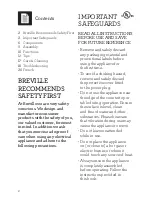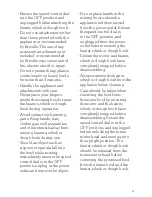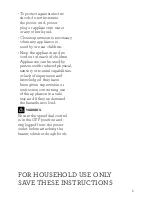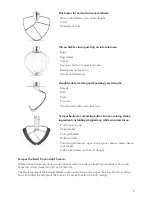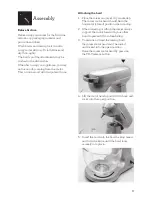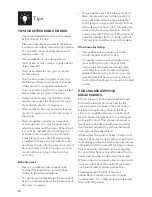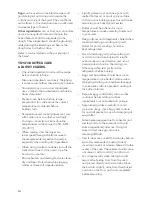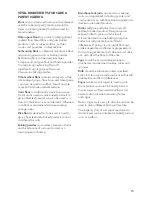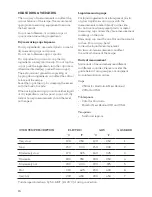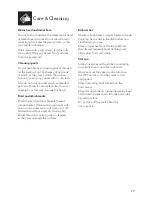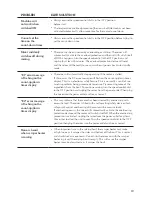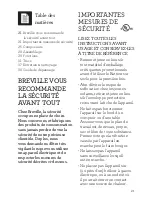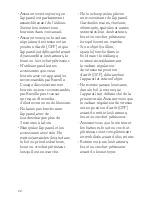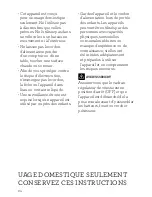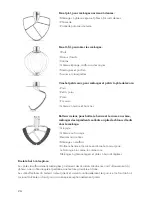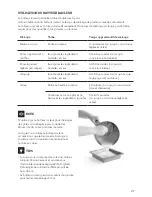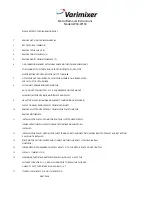
12
Tips
TIPS FOR BETTER BREAD MAKING
•
Check the ingredients and read the recipe
before starting to bake.
•
Measure ingredients accurately. Weighing
is more accurate than measuring by volume.
To accurately measure water please note
that 1ml water = 1g.
•
Use ingredients at room temperature.
•
Don’t use flour that contains a protein level
of less than 11%.
•
Don’t use tableware cups, jugs or spoons
for measuring.
•
Don’t use hot water or liquids as this can
kill the yeast. Water and liquids should be
added at a warm or tepid temperature.
•
Don’t use self-raising flour to make yeasted
bread unless recipe states otherwise.
•
In high altitude areas above 900m, lower
air pressure causes the dough to rise faster.
Try reducing yeast by
¼
teaspoon.
•
If the weather is hot and humid, reduce the
yeast by ¼ teaspoon to avoid over rising of
the dough.
•
Flour properties can alter on a seasonal
or storage basis, so it may be necessary to
adjust the water and flour ratio. If the dough
is too sticky, add extra flour 1 tablespoon
at a time if the dough is too dry add extra
water 1 teaspoon at a time. A few minutes
is needed for these extra ingredients to be
absorbed. Dough with the correct amount of
flour and water should form into a smooth,
round ball that is damp to the touch but
not sticky.
Activate yeast
•
Fresh or compressed yeast needs to be
‘sponged’ (fermentation started) before
adding to the other ingredients.
•
To substitute, use three times the amount of
fresh or compressed yeast for the amount of
dry yeast in a recipe.
•
To sponge the yeast: Place the quantity of
fresh compressed yeast in the quantity of
(warmed) water from the recipe together
with 1 teaspoon sugar and 1 teaspoon flour
into a clean glass bowl, stir to dissolve and
cover with plastic wrap. Allow to stand in
a warm area (30°C) for about 30 minutes or
until the mixture starts to bubble and froth.
This mixture should be used without delay.
Warm area for rising
•
Yeast, either when sponging or in the
dough, requires warmth to rise.
•
To create a ‘warm area’ for dough to rise,
place baking tray over a bowl of fairly
warm water, place prepared dough item
on baking tray, cover loosely with lightly
greased thicker-style plastic wrap or a tea
towel. Ensure kitchen is warm and free of
drafts. Allow the dough to rise until doubled
in size.
VITAL INGREDIENTS FOR
BREAD MAKING
Flour is the most important ingredient used
for bread making. It provides food for the
yeast and gives structure to the loaf. When
mixed with liquid, the protein in the flour
starts to form gluten. Gluten is a network of
elastic strands that interlock to trap the gases
produced by yeast. This process increases as
the dough continues kneading and provides
the structure required to produce the weight
and shape of the baked bread.
White wheat flour sold as baker’s, bread or all-
purpose flour may be used. All-purpose flour is
most readily available, however, best results are
obtained with flour at least 11% protein content.
This is normally indicated on the packaging.
Do not sift the flour or use self-raising flour for
bread making unless indicated in the recipe.
When using a low-protein, plain, stone ground
or whole wheat flour the quality of the bread
can be improved by adding gluten flour.
There are several brands of bread or
bakers flour available nationally at larger
supermarkets. It is a high protein, white bread
flour, with 11% protein.
Содержание Bakery Boss BEM825
Страница 1: ...the Bakery Chef Instruction Book BEM825 ...
Страница 20: ...the Bakery Chef Manuel d instructions BEM825 ...


